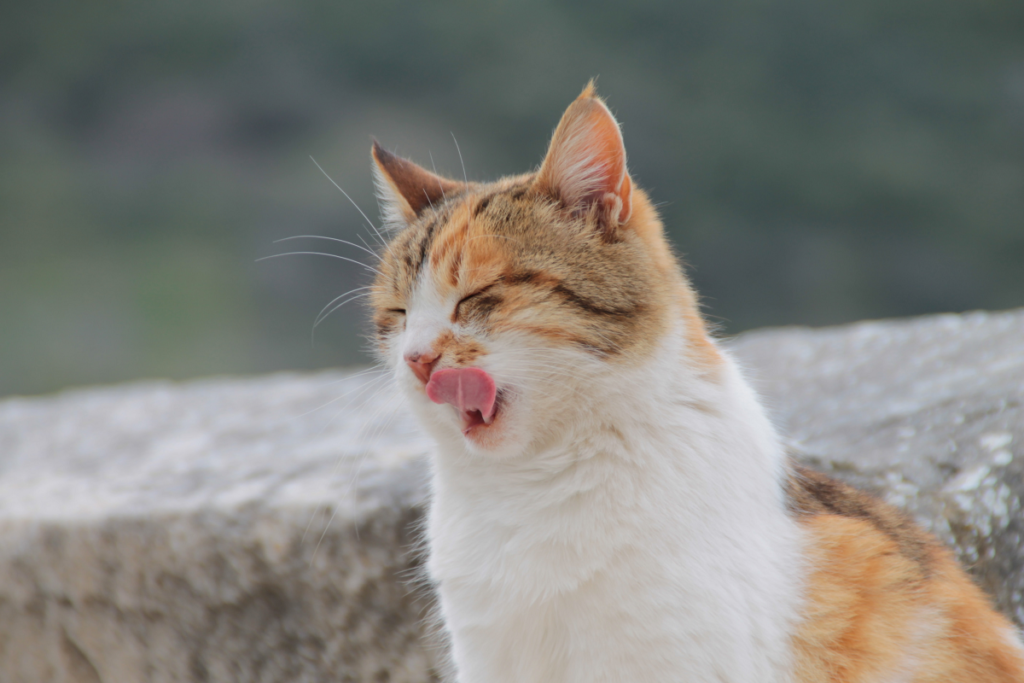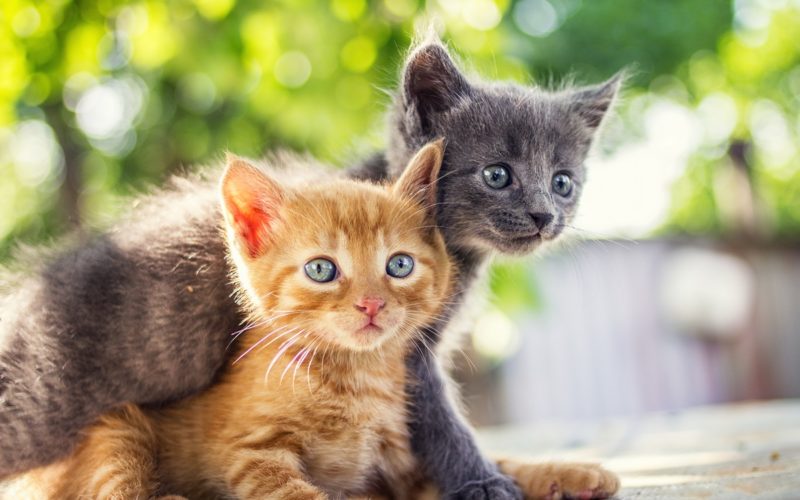Gum disease, also known as periodontal disease, is commonly defined as an inflammatory condition which irreversibly damages the periodontium. The periodontium is made up of the following four structures: gingiva, cementum, alveolar bone, and periodontal ligament. Early periodontal disease is diagnosed when x-rays can confirm the physical tissue separation between the teeth and gums. Breakage of this tissue is synonymous with damage and loss to critical bone and supporting structures. This painful, costly, and even deadly disease is more common than you might expect. 85 percent of cats aged four years and up suffer from one or more symptoms associated with periodontal disease. The key is to educate, treat, and prevent!
Causes of Feline Periodontal Disease
Gum disease in cats is caused by the accumulation of sticky foodborne bacteria, also known as plaque. Every time a cat’s teeth contacts food, plaque develops on the smooth enamel of the tooth’s surface. Most of this accumulated plaque, is dispersed from the friction of normal chewing. Depending on a cat’s diet, age and genetic predisposition, some of this plaque may not come off so easily. Plaque that remains on the teeth for more than one day will begin to mineralize from salts present in the saliva. Eventually, this outer layer will harden to form tartar or calculus. Without preventative action to remove the calculus, it can build up and evolve into periodontal disease. From there, the problem can escalate to more serious health problems. Here are some of the internal and external factors that can make certain cats more susceptible than others:
Diet
The chemical transformation of plaque to tartar takes place even quicker when cats are given sticky foods. An example may be a slice of meat topped with a glucose-laden barbecue sauce, ketchup, or mustard. Given a feline-friendly diet, hard cat food is preferable to canned food. This is because the consumption of hard food corresponds with a greater amount of friction during the 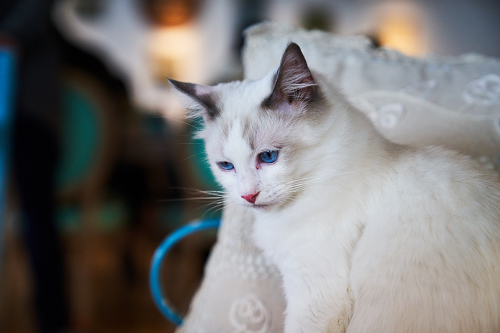 normal chewing process, able to remove plaque while eating.
normal chewing process, able to remove plaque while eating.
Genetics
Variations in oral genetics can make certain cat breeds more predisposed to gum disease than others. Purebred breeds are especially at risk for acquiring gum diseases, as well as other dental and general health problems. This is due to the selective breeding for certain genetic traits, which may not always be in the cat’s best interest. Commonly cited examples of cats with an increased susceptibility to periodontal disease include the Siamese, Persian, and Bengal breeds.
Oral Misalignment
Instances of oral misalignment, or malocclusion, occur when a cat’s teeth do not line up properly. During the time span between a kitten and adult, four teeth must develop. If teeth are improperly sized or spaced, the top and bottom jaws will not properly align. Generally, this results in excess space between the top and bottom rows of teeth, which also coincides with reduced friction when chewing. This is troublesome because the lack of friction will produce more plaque to accumulate.
Stages and Symptoms
The buildup of rough tartar surfaces makes it incrementally more difficult to remove the plaque by natural means. If a cat’s teeth are not regularly brushed, the tartar surface will function as a breeding ground for more foodborne bacteria. Thankfully, if symptoms are detected early, damage can be reversed. If the disease is allowed to proceed to stage two symptoms, incremental damage becomes irreversible. Left unchecked the disease will progress and incremental amounts of bone will be lost around the highly sensitive, tooth roots. As the disease progresses, various organs will be damaged and eventually fail. Even death may result due to dangerously high levels of bacteria present in the bloodstream. This makes it extremely important for cat owners to understand the stages, identify the symptoms, and know when to seek veterinary treatment.
Stage 1: Pre-Periodontal Disease
Symptoms associated with pre-periodontal disease are treatable and reversible. These signs can eventually lead to early periodontal disease but are not yet severe enough to warrant a diagnosis by a veterinarian. However, that doesn’t mean you should ignore these early symptoms! In this stage, one or more teeth are affected by gingivitis. Gingivitis is easily discovered by simply looking at your cat’s gums. At home you may notice that your cat’s gums are visibly red and mildly swollen. Teeth will likely show signs of early tartar formation, which look like slight crusty yellow ledges forming at the gumline. If this is the case, check for the presence of thin red line that borders the space between the teeth and gums. It is not uncommon to have a noticeable odor coming from your cat’s breath as well. In an office setting the veterinarian might use a microscopic lens to assess tartar buildup and check for the beginning of gum-tooth damage. If this damage is observed, the disease has progressed in stage two.
Stage 2: Early Periodontal Disease
Stage two, or early periodontal disease, marks the beginning of bone loss and should not be taken lightly. From this point forward, all oral changes are irreversible by natural means. Unlike stage one, veterinarians do not need to use a microscopic lens to diagnose plaque and tartar buildup-an excessive amount is easily seen. They will use oral radiographs or x-rays to assess bone loss, which is also referred to as gum-tooth separation. In stage two, this damage can range from 0-25%. Along with microscopic observations, oral x-rays help to assess the amount of bone loss. Along with the start of bone loss, stage two symptoms will include obvious bad breath and visibly swollen red gums.
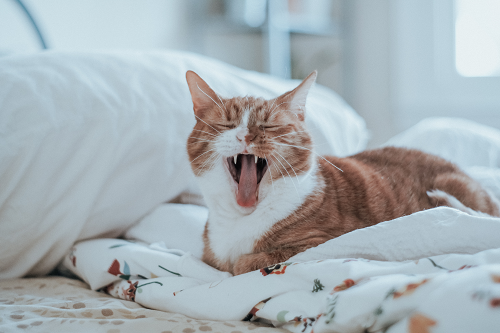 Stage 3: Moderate Periodontal Disease
Stage 3: Moderate Periodontal Disease
Moderate periodontal disease is the last stage of changes that are only localized orally. At this point, fatal amounts of oral bacteria have not yet entered the bloodstream where they can damage vital organs. In stage three, oral radiographs show a serious amount of bone and tissue detachment within the range of 25-50%. This extreme amount of gum-tooth separation is large enough to form periodontal pockets. If periodontal pockets are not reduced with an intensive oral cleaning, surgery may be required. If these pockets are severe, the affected teeth will likely require immediate extraction. Stage three symptoms include bad breath, difficulty eating, or total feline appetite loss due to extreme pain. Gums will bleed easily upon contact, appearing extremely red and highly swollen.
Stage 4: Extreme Periodontal Disease
Extreme periodontal disease, or periodontitis, is the most advanced form and the precursor to death. In this fatal form, the tooth roots are exposed due to excessive gum recession. Oral radiographs indicate a gum-bone attachment loss of more than 50%. This extreme level of oral damage puts the body at a higher risk of systemic infection, which may necessitate extensive tooth extraction. Reports of fatality are also common at this stage due to the widespread permeation of bacteria from the gums into the bloodstream, resulting in organ disease, feline inflammation, and eventually a total body shutdown. Studies have often found an association with this disease affecting the heart, liver, and kidneys.
Diagnosis of Gum Disease in Cats
- Annual Pet Wellness Exam: This includes an oral component. During this exam, veterinarians will conduct a thorough visual observation of the cat’s mouth to determine whether or not further testing is warranted. In this case, periodontal probing may be performed.
- Periodontal Probing: If more than 1 mm can be measured between the teeth and gums, then a periodontal abnormality is present. The condition has now gone past gingivitis.
- X-Rays: Also known as oral radiographs, these are useful in determining the amount of bone loss. This procedure is critically important for ensuring a proper diagnosis. Although the visual symptoms detailed above are important, the x-rays are crucial for display the level of bone loss and determining the stage of the disease.
Treatment For Gum Disease
All stages of periodontal disease recommend daily brushing with a feline-friendly toothpaste and correct technique for a duration of one minute or longer. As the disease progresses, oral homecare will become increasingly more painful for the cat and difficult for the person brushing. To avoid this incremental resistance, start early!
Stage 1
Stage one treatment methods are centered around two goals – control plaque and prevent attachment loss. To accomplish these goals, most veterinarians will recommend a professional teeth cleaning and polishing. Depending on the amount of tartar buildup, this procedure typically lasts for 45-75 minutes and requires general anesthesia. The appointment will typically end with the veterinarian prescribing a medical-grade fluoride to kill bacteria and minimize plaque formation.
Stage 2
Stage two is characterized by loss of bone, or tooth support. The goal of all treatments and prescriptions are centered around preventing and minimizing continued bone loss. At this point, a professional deep cleaning may be performed on the same day due to this extreme level of urgency.
Stage 3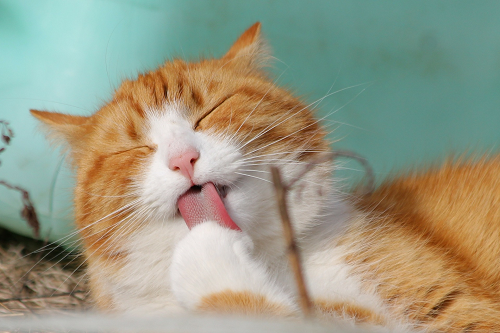
Evaluated on a case-by-case basis, stage three treatment options will likely include one or more of the following procedures:
- Extraction: While tooth removal may seem extreme, it is the only way to prevent the disease from advancing at the current tooth, then spreading to surrounding teeth. At this state of disease progression, cats will likely exhibit extreme resistance to brushing due to their severe pain. Even delicious-tasting toothpaste might not do the trick. Cat owners will need to be strong enough to hold down their cat and wear protective, scratch-resistant clothing. Committing to daily gentle brushing may save a cat’s life. For owners who are reluctant to engage in this preventative practice, extraction of multiple teeth may slow, but not eradicate, the disease.
- Advanced Periodontal Treatment: This specialized treatment is expensive because it can only be performed by a veterinary dentist. Due to the technical complexity involved, the procedure is outside the scope of what can be done by a general veterinarian. This method is performed when cat owners opt to preserve the tooth and can commit to daily brushing. Examples of advanced procedures include bone-replacement, periodontal splinting, and guided tissue regeneration.
Stage 4
In stage four, extraction is no longer an option; it is an urgent necessity. In extreme cases, 50% or more of a cat’s 30 teeth may require extraction. To put this in perspective, individual tooth extraction typically ranges from $500-800. This range depends on the cat’s overall health and risks of complications. Given that the extraction is due to a stage four periodontal disease, budget for the high end of this range. A range from 1 to 15 would result in a total cost of $800 to $12,000, which does not include post-operative medications and required follow-up appointments.
Feline Gum Disease Prevention
Symptom Identification
Now that you are aware of the stages and symptoms of gum disease in cats, prevent disease progression through early symptom identification. This can save your cat from needless pain, and your wallet too!
Oral Hygiene
Veterinarians commonly recommend brushing your cat’s teeth for one minute every day. Although this may sound challenging, it is possible. To help make this process more hassle-free for your cat (and you!), consider using a toothpaste with a tasty feline flavor such as chicken, beef, or salmon. Regardless of flavor, be sure the selected toothpaste is pet friendly as human-grade toothpaste can be fatal upon feline consumption.
Veterinary Care
No one said you can only go to the veterinarian once a year for an annual wellness exam! If your cat has bad breath or red puffy gums, consider visiting your veterinarian for more regular dental cleanings and checkups. Other than daily brushing, regularly scheduled dental cleanings is the second-best way to prevent periodontal disease development and progression. If the disease is already diagnosed as stage one or higher, it is increasingly important to see a veterinarian for a cleaning, prescription, or surgical procedure on an as-needed basis. As with any disease, ask your veterinarian to recommend an appropriate time span between appointments.
Prescription Food
To ensure progress between medical visits, your veterinarian may recommend a prescription cat food. This dietary change is not intended to replace regular brushing, but supplement it. Prescription cat foods for feline dental disease are clinically proven to help reduce plaque buildup in comparison to over-the-counter alternatives.
As with most diseases, symptoms worsen over an extended period of time, not overnight. Since symptoms can become extremely painful, it is important to adhere to a daily brushing routine before this becomes an issue. A healthy cat can be kept out of trouble by have a cleaning done once a year. If the cat is showing symptoms found in stage one or two, the frequency needs to increase to twice or three times a year. Seek advice from a veterinarian before buying any products online as many of these treatments lack the clinical testing needed to back their claims. Eating is one of the most enjoyable parts of a cat’s day – and it’s up to the owner to keep it that way!
Sources
“8 FAQs about dental disease in cats (Feline Periodontal Disease).” MedicAnimal, Accessed 15 Jun. 2019. https://www.medicanimal.com/8-FAQs-about-dental-disease-in-cats-Feline-Periodontal-Disease/a/ART111484.
“Causes & Signs of Dental Disease in Cats.” Hill’s, Accessed 15 Jun. 2019. https://www.hillspet.com/cat-care/healthcare/feline-dental-disease.
“Common Purebred Feline Disorders.” Animal Wellness Center, Accessed 15 Jun. 2019. http://www.awcwi.com/CatBreeds.
“Frequently Asked Questions.” Forever Pet Dental, Accessed 15 Jun. 2019. https://foreverpetdental.com/faqs/.
“Gum Disease.” American Dental Association, Accessed 15 Jun. 2019. https://www.mouthhealthy.org/en/az-topics/g/gum-disease.
“Gum Disease in Cats.” PetMD, Accessed 15 Jun. 2019. https://www.petmd.com/cat/conditions/mouth/c_ct_periodontal_disease.
“Periodontal Disease.” American Veterinary Dental College, Accessed 15 Jun. 2019. https://www.avdc.org/periodontaldisease.html.
“Periodontal Disease in Cats.” VetStreet, Accessed 15 Jun. 2019.
http://www.vetstreet.com/care/periodontal-disease-in-cats.
“Periodontal Tissues.” eMedia, Accessed 15 Jun. 2019. https://www.rvc.ac.uk/showcase/Dentistry/Periodontal/perTissues/periodontium.html.
“Reverse Gum Disease: Don’t Miss Your Window of Opportunity.” Colgate, Accessed 15 Jun. 2019. https://www.colgate.com/en-us/oral-health/conditions/gum-disease/reverse-gum-disease-dont-miss-your-window-of-opportunity-0914.
“Teeth Misalignment in Cats.” PetMD, Accessed 15 Jun. 2019. https://www.petmd.com/cat/conditions/mouth/c_ct_malocclusion_misalignment_of_teeth.
“The Four Stages of Pet Dental Disease.” Lone Tree Veterinary Medical Center, Accessed 15 Jun. 2019. http://www.lonetreevet.com/blog/pet-dental-disease/.
“Tooth Removal in Dogs.” Wag!, Accessed 15 Jun. 2019. https://wagwalking.com/treatment/tooth-removal.
“What are Periodontal Pockets?” Colgate, Accessed 15 Jun. 2019. https://www.colgate.com/en-us/oral-health/conditions/gum-disease/what-are-periodontal-pockets-0315.

